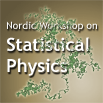Speaker
Giulia Rossi
(Aalto University School of Science)
Description
G. Rossi (1), L. Monticelli (2), S. R. Puisto (3), N.
Rostedt (3), I. Vattulainen (4) and T. Ala-Nissilä (1)
(1) Department of Applied Physics, Aalto University School of Science, P.O. Box 11000, 00076 Aalto, Espoo, Finland
(2) INSERM, UMR-S 665, DSIMB, 6 rue Alexander Cabanel, 75015 Paris, France
(3) MatOx Pembroke House, 36-37 Pembroke Street, Oxford OX1 1BP, United Kingdom
(4) Department of Physics, Tampere University of Technology, P.O. Box 692, FI-33101 Tampere, Finland
Optimization of polymer properties in industrial applications is generally achieved by controlling the fine details of their chemical composition, often through expensive and time-consuming trial-and-error procedures. Computer modelling can speed up these procedures by predicting changes in material properties as a function of chemical composition. Unfortunately, the classical simulations of polymer melts from atomistic detail are subject to stringent limitations to the time and length scales of the phenomena that can be observed.
Coarse-graining strategies can help to overcome these limitations. Coarse-graining involves grouping clusters of atoms into super-atoms, or beads. Coarse-grained (CG) models are computationally faster than atomistic ones thanks to a reduction in the number of degrees of freedom and the use of smoother interaction potentials, allowing for longer time step in molecular dynamics (MD) simulations. We introduce a new hybrid thermodynamic-structural approach to the coarse- graining of polymers. The new model is developed within the framework of the MARTINI force-field [Marrink et al., J. Phys. Chem. B, 2007, 111, 7812], which uses mainly thermodynamic properties as targets in the parameterization. Density and structural properties of the polymer melt can be used to refine the force-field parameterization. We test our procedure on polystyrene [G. Rossi et al., Soft Matter, DOI:10.1039/C0SM00481B], a standard benchmark for coarse-grained polymer force-fields. Structural properties in the melt are well reproduced, and their scaling with chain length agrees with available experimental data. The CG force-field shows reasonable transferability between 350 and 600 K. The model is computationally efficient and polymer melts and solutions can be simulated by MD over length scales of tens of nanometers and time scales of tens of microseconds.
Two applications of polymer models developed within the MARTINI framework are shown. The first concerns the dynamics of polystyrene-C60 nanocomposites, a system that has been shown to have unusual rheological and mechanical properties. The second application concerns a polyester resin, whose mechanical properties are investigated by means of non-equilibrium molecular dynamics simulations.
(1) Department of Applied Physics, Aalto University School of Science, P.O. Box 11000, 00076 Aalto, Espoo, Finland
(2) INSERM, UMR-S 665, DSIMB, 6 rue Alexander Cabanel, 75015 Paris, France
(3) MatOx Pembroke House, 36-37 Pembroke Street, Oxford OX1 1BP, United Kingdom
(4) Department of Physics, Tampere University of Technology, P.O. Box 692, FI-33101 Tampere, Finland
Optimization of polymer properties in industrial applications is generally achieved by controlling the fine details of their chemical composition, often through expensive and time-consuming trial-and-error procedures. Computer modelling can speed up these procedures by predicting changes in material properties as a function of chemical composition. Unfortunately, the classical simulations of polymer melts from atomistic detail are subject to stringent limitations to the time and length scales of the phenomena that can be observed.
Coarse-graining strategies can help to overcome these limitations. Coarse-graining involves grouping clusters of atoms into super-atoms, or beads. Coarse-grained (CG) models are computationally faster than atomistic ones thanks to a reduction in the number of degrees of freedom and the use of smoother interaction potentials, allowing for longer time step in molecular dynamics (MD) simulations. We introduce a new hybrid thermodynamic-structural approach to the coarse- graining of polymers. The new model is developed within the framework of the MARTINI force-field [Marrink et al., J. Phys. Chem. B, 2007, 111, 7812], which uses mainly thermodynamic properties as targets in the parameterization. Density and structural properties of the polymer melt can be used to refine the force-field parameterization. We test our procedure on polystyrene [G. Rossi et al., Soft Matter, DOI:10.1039/C0SM00481B], a standard benchmark for coarse-grained polymer force-fields. Structural properties in the melt are well reproduced, and their scaling with chain length agrees with available experimental data. The CG force-field shows reasonable transferability between 350 and 600 K. The model is computationally efficient and polymer melts and solutions can be simulated by MD over length scales of tens of nanometers and time scales of tens of microseconds.
Two applications of polymer models developed within the MARTINI framework are shown. The first concerns the dynamics of polystyrene-C60 nanocomposites, a system that has been shown to have unusual rheological and mechanical properties. The second application concerns a polyester resin, whose mechanical properties are investigated by means of non-equilibrium molecular dynamics simulations.

